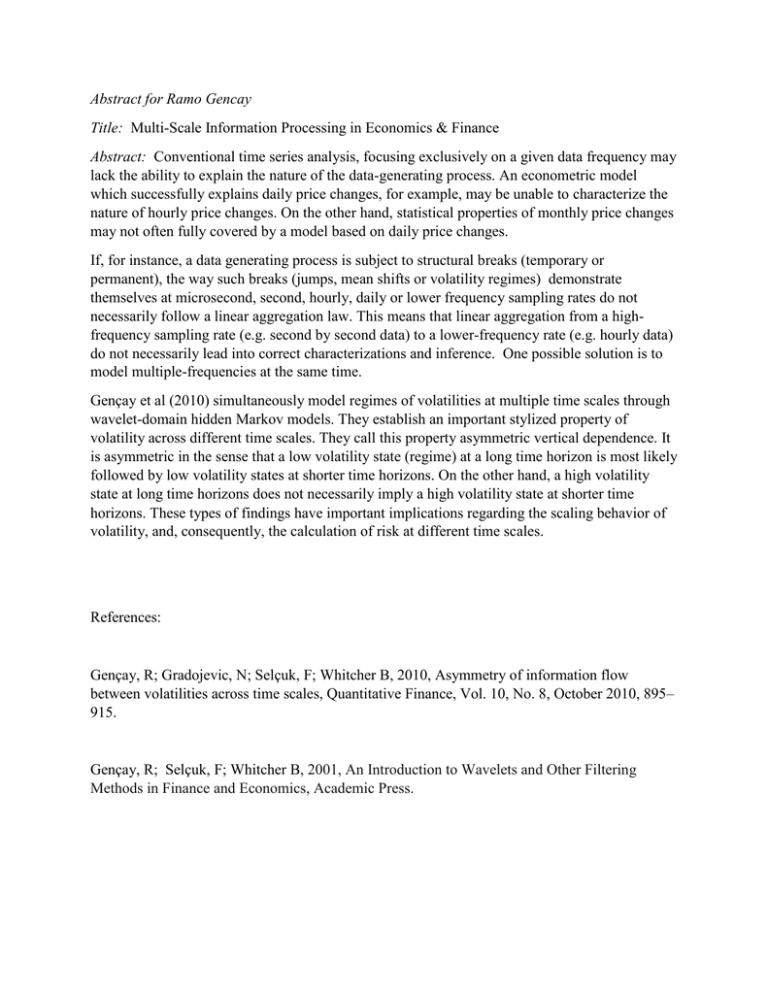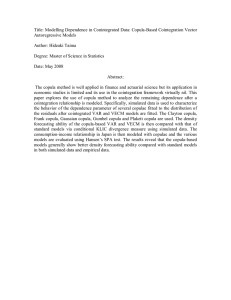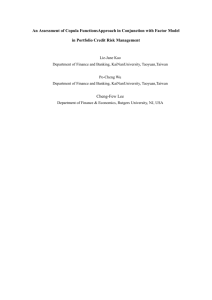Abstract for Ramo Gencay Title: Abstract:
advertisement

Abstract for Ramo Gencay Title: Multi-Scale Information Processing in Economics & Finance Abstract: Conventional time series analysis, focusing exclusively on a given data frequency may lack the ability to explain the nature of the data-generating process. An econometric model which successfully explains daily price changes, for example, may be unable to characterize the nature of hourly price changes. On the other hand, statistical properties of monthly price changes may not often fully covered by a model based on daily price changes. If, for instance, a data generating process is subject to structural breaks (temporary or permanent), the way such breaks (jumps, mean shifts or volatility regimes) demonstrate themselves at microsecond, second, hourly, daily or lower frequency sampling rates do not necessarily follow a linear aggregation law. This means that linear aggregation from a highfrequency sampling rate (e.g. second by second data) to a lower-frequency rate (e.g. hourly data) do not necessarily lead into correct characterizations and inference. One possible solution is to model multiple-frequencies at the same time. Gençay et al (2010) simultaneously model regimes of volatilities at multiple time scales through wavelet-domain hidden Markov models. They establish an important stylized property of volatility across different time scales. They call this property asymmetric vertical dependence. It is asymmetric in the sense that a low volatility state (regime) at a long time horizon is most likely followed by low volatility states at shorter time horizons. On the other hand, a high volatility state at long time horizons does not necessarily imply a high volatility state at shorter time horizons. These types of findings have important implications regarding the scaling behavior of volatility, and, consequently, the calculation of risk at different time scales. References: Gençay, R; Gradojevic, N; Selçuk, F; Whitcher B, 2010, Asymmetry of information flow between volatilities across time scales, Quantitative Finance, Vol. 10, No. 8, October 2010, 895– 915. Gençay, R; Selçuk, F; Whitcher B, 2001, An Introduction to Wavelets and Other Filtering Methods in Finance and Economics, Academic Press. Abstract for Jan van Leeuwen Title: The Scope of PIIP Abstract: • Information processing is a key issue in computer science. It became a metaphor in understanding cognitive processes, leading to the multi-stage view of the way humans deal with information. What do we understand information processing to be, today? • The scene of information processing has changed to data science: – Data now consists of streams and piles of data. Information is embedded in it, in some known or unknown way and perhaps without knowing precisely what it is. – Information processing is a process of iterated filtering, with suitable means and with or without quantitative restrictions on it. – The programs that govern the processing learn and adapt, and may change depending on the data they receive over time and the interactions they engage in. • How do we look at information processing now? What do the insights about streaming, dataand process-mining, and adaptive processes imply? Why is information processed? what does one get from it? • Some questions: – Streams give an infinite dimension to data. What does this mean for the concept of information? – Is there a general classification of information processing, based on the means that are used and the information that is processed? – Suppose the observer and the observed interact, implying that the data exchanged become interaction-dependent over the course of the exchange. Can information processing be explained game-theoretically? – Information processing and computation are generally equated but not considered equal, based however on a traditional view of both. Can the difference, if any, be made more tangible, in view of the evolved conceptions of both information processing and computation? – Can information processing, like computation, be captured in a model that allows one to express its generic properties, whatever these properties are? • Is the philosophy of data science a philosophy of information processing? • What role does information processing play in the understanding of natural complex systems? Conversely, what do these systems learn about information processing? Abstract for Giuseppe Primiero Title: Negating Trust: intentionality and enemy mine Abstract: Trust has recently become a crucial epistemic notion for many areas across the computational sciences spectrum to identify relevant, secure or preferred agents, communications and information contents. In the last two decades, research on trust has developed mainly quantitative approaches focusing on the understanding, modelling and anticipation of trust propagation. Such analyses heavily rely on the correct formal representation of transitive trust: If Alice trusts Bob and Bob trusts Carol, then Alice trusts Carol. This represents a main issue for security protocols, efficient reputation and recommendation systems and algorithm personalisation. These solutions are extending towards the identification of various quality criteria, among which understanding of negative values of trust is essential. Transitivity applies in this case as well: Alice does not trust Bob; Bob does not trust Carol; does Alice trust Carol? To contribute to this debate, we offer an intentional interpretation on the semantics of data, changing the perspective on how (un)trust transitivity should be accounted for, and how agents are supposed to act in view of such assessments. We introduce an overview of the different meaning of trust and untrust in the computational context, considering how they have been influenced by interpretations from the social sciences. Afterwards, we present an account of the notions of trust, distrust and mistrust that heavily relies on the analysis of the agents' intention and procedures induced by their beliefs. We define distinct procedural protocols for each of these notions and explain how enemy mine situations are specific to intentional transmission of false information. An evaluation based on intentionality criteria can offer a sensibly better solution in many cases when combined with a quantitative and computationally feasible approach, ameliorating conditions for a number of current applications based on simple and straightforward reputation methods such as web search results ranking algorithms. Abstract for Marcin J. Schroeder Title: Structural and Quantitative Characteristics of Information from the Point of View of Invariance Abstract: The concept of symmetry, i.e. of invariance with respect to transformations of the object of study is fundamental for scientific methodology. We can trace its role retroactively in the entire development of physics and other disciplines, even before mathematical tool for the study of symmetry (group theory) was born. The perspective of symmetry and invariance became a commonly recognized program of the mathematical inquiry in the 19th Century (Erlangen Program of Felix Klein) to become in the next century main tool of physics (Noether’s Theorem), chemistry, biology, and finally to permeate psychology (Jean Piaget) and even cultural anthropology (Claude Levi-Strauss). The discovery of breaking symmetry in nature marked the turning points of physics (e.g. Special Relativity, unification of physical interactions, etc.) It is an interesting twist of the early history of information studies that it was invariance with respect to change of encoding of information, from which Ralph Hartley derived the measure of information in his 1928 article marking the beginning of information science. Hartley was aware of the importance of invariance, but because of his conviction that structural aspects of information belong to psychology, not engineering disregarded the constraints on transformations. Claude Shannon did not continue Hartley’s investigation of invariance and explored the issue of structural characteristics of texts in terms of conditional probabilities in sequential choices of characters, but without much success. Invariance disappeared from the study of information dominated by the quantitative methodology focused on entropy fully invariant with respect to arbitrary transformations of the underlying set (alphabet). The attempts of Yehoshua BarHillel and Rudolf Carnap in 1952 to introduce structural analysis of information in terms of logic did not bring lasting results. It is interesting that the linguistic revolution of Noam Chomsky did not revive interest in this subject. Although Rene Thom developed his study of information exactly in the spirit of invariance, he distanced himself from the orthodox information theory so vigorously that his work did not influence information science. The first step towards the structural study of information is its conceptualization incorporating both aspects of information – selective and structural. The presentation utilized the approach developed by the present author in several publications in last decade, in which information is defined as identification of a variety, i.e. that which makes one out of many. Selection is one mode of identification, a structure imposed on the variety is another. Both manifestations can be formalized in a mathematical way in terms of closure spaces. Set of closed subsets in such space has the structure of a complete lattice (generalization of a Boolean algebra), which can be considered a generalization of logic for not necessarily linguistic forms of information. The properties of this logic of information may serve as a basis for the structural analysis of information. For instance, the level of decomposability of the logic into components can be identified as the level of information integration characterizing structural manifestations of information. On the other hand, if this logic admits probability measure (not always it is possible), we can define quantitative measures of the type of entropy to characterize selection (although it may be argued that better measures than entropy are possible). The entropy type of measure is related to selection, so it is not a surprise that it is an invariant of a larger class of transformations than those associated with structural manifestations. In the presentation a new quantitative measure of information integration m*(L), which is an invariant of transformations preserving structure is proposed and its basic properties are reviewed. Abstract for Paolo Rocchi Title: What Information to Measure – How to Measure? Abstract: This talk addresses the official argument of the present workshop that is the information metrics, and means to suggest a new strategy of research. Information theorists put forward several and different definitions so far. Some of the information definitions are more technical in nature, others are more abstract and broad-based. The concept of information is still liquid. While theorists have not reached a definitive solution, as matter of facts engineers prepare astonishing digital appliances. Other scholars have found out intriguing informational phenomena in Nature. For instance biologists have discovered and decoded the DNA of several living beings. I wonder: What culture or what notions do these productive actions sustain? I have observed that professionals and researchers coming from various domains exploit the semiotic scheme that they use through intuition. They adopt the concepts of signifier and signified in a pragmatic manner and without using the semiotic terminology. The same Shannon uses the notions of signifiers and signified without mentioning them in his seminal work. Concluding, we cannot say what is information and in consequence we cannot measure it, but could follow a novel pragmatic vein of research. We could study the notions of signifier and signified from a scientific-mathematical perspective due to the popularity of the semiotic scheme, and could measure the semiotic elements. This talk does not develop a purely political account; I have made some steps toward the innovative direction of research. I suggest a formal definition for the signifier by means of an inequality. Several measures can be derived from this inequality; in particular I have demonstrated that the inequality lies at the base of the information technology though it is used by intuition. In addition the present theory can answer to some vexed philosophical arguments and can demonstrate in formal terms: #1 Digital signals are perfect instead analog are fuzzy. #2 The perception fallacy conundrum is an ill-posed argument and therefore has many solutions. #3 Information is a relativistic concept. #4 ‘Nothing’ is a potential vehicle of information and does not deny the information physicism. The proposed formal solution demonstrates to offer benefits to practitioners and philosophers of information as well. Abstract for J. Michael Dunn Title: Relevance Logic as an Information-based logic Abstract: There are obviously connections between formal logic and database theory, and hence between formal logic and information processing. Unfortunately these connections while in one sense obvious, are in a deeper sense not as well understood and utilized as one might naively expect they should be. There are many reasons for this, but one is surely that the concept of information is kind of buried in the semantics (model-theory) of classical logic. Here we shall explore information based approaches to one of the best known non-classical logics, variously called relevance logic, or relevant logic. From the beginnings of relevance logic there has been much controversy about its semantics. First there was complaint that it had none, and then there was the complaint that it had one, particularly the so-called "Routley-Meyer semantics" for relevance logic -- which used the novelty of a ternary accessibility relation in rough analogy to the binary relation that Kripke used in his semantics for modal logic. I shall explore the idea that the terms of the relation are information states, and that Rabc can be understood in one of the following three ways: 1. Information Combining Interpretations: the piece of information a when combined with b equals c (Urquhart) or is included in c (Fine). 2. Computational Interpretation: view information state a as "input" and view the information state b as a stored program. Information state c is a potential result of running the program on that input (Dunn). 3. Program Combining Interpretation: view information states a and b both as stored programs, and view the result of composing these two programs as equal to (or included in) the information state which is the stored program c (Dunn). The informational interpretation 1 in Fine’s version was shown to be sound and complete with respect to the logic of relevant implication R. Informational interpretations 2 and 3 give different related logics. Abstract for Jeff Racine Title: Five Top Challenges in Philosophy of Information and Information Processing Abstract: • there has been a preoccupation with moment-based inference (which can lead to inconsistent inference, e.g., two distributions have same mean but differ almost everywhere) • one challenge is to educate practitioners on the benefits of using entropic measures of divergence • implementation of entropic measures raises questions of ill-posedness, e.g., the PDF is the derivative of the CDF, yet uniformly consistent estimators such as the ECDF cannot be plugged into the definition of the density based on a derivative (this constitutes an `ill-posed problem’) • kernel smoothing techniques have emerged as a popular means of overcoming the ill-posed problem • however, this imparts information on the resulting entropic measures of divergence • so a related challenge is how best to go beyond moment-based inference while quantifying the amount of information imparted on the entropic measure by kernel smoothing • so, to summarize, ideally we educate practitioners to move beyond restrictive moment-based inference, but perhaps maximize the mutual information between non-smooth empirical distribution and the smooth distributions that are made necessary due to ill-posedness of certain problems Abstract for Ximing Wu Title: Information-Theoretic Assessment of Copula-based Analysis Abstract: Joint distributions of multivariate random variables can be expressed as joint distributions of corresponding marginal distributions, leading to the copula representation. Copula functions completely summarize dependence among random variables. Copula-based approaches have become popular, partially due to its separation of marginal distributions from the dependence. This note cautions that the advantage of copula-based analyses hinges on the simplicity of copulas. If a joint distribution is complicated while its copula function is simple, estimations can benefit from transformation into the copula domain. In contrast, in the presence of complicated copula functions, the costs of copula estimations may outweigh its benefits. We note that mutual information can be interpreted as copula entropy. Furthermore, copula entropy is also the relative entropy between a copula density and the uniform density, which reflects the complexity of a copula and hence the difficulty of its estimation. Consequently information theories provide a natural framework to assess the suitability of copula-based analyses.


